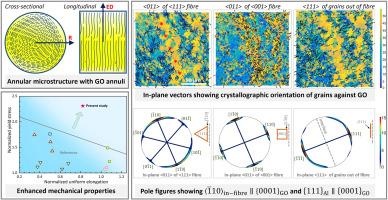层状结构和晶体取向增强氧化石墨烯增强铝的力学性能
IF 11.6
2区 材料科学
Q1 CHEMISTRY, PHYSICAL
引用次数: 0
摘要
通过粉末冶金和机械加工制备氧化石墨烯(GO)增强铝(Al)复合材料,获得了具有晶体取向的层状微观结构。与不含氧化石墨烯的材料相比,添加1.0 wt%氧化石墨烯的拉伸屈服应力几乎增加了一倍,均匀伸长率从12%略微降低到10%。电子背散衍射分析揭示了GO层和铝基体之间的晶体学关系,其中⟨111⟩和⟨001⟩纤维中的⟨1 10:00⟩Al,以及双纤维外的{111}Al,倾向于与界面平行,例如在纤维∥{0001}GO和{111}of -纤维∥{0001}GO中的⟨1 10:00⟩。详细研究了其形成机制,并将其归因于石墨烯对高温机械加工过程中位错滑移和动态再结晶的影响。此外,分子动力学模拟表明,{111}Al∥{0001}GO的排列促进了界面处全位错向Shockley部分的解离,减轻了错配应力,显著提高了复合材料的力学性能。这些发现突出了氧化石墨烯在定制微结构和增强金属基复合材料方面的潜力。本文章由计算机程序翻译,如有差异,请以英文原文为准。

Enhanced mechanical properties of graphene oxide reinforced aluminum with lamellar microstructure and crystallographic alignment
A lamellar microstructure with crystallographic alignment was achieved in graphene oxide (GO) reinforced aluminum (Al) composites fabricated via powder metallurgy and mechanical processing. The addition of 1.0 wt% GO nearly doubled the tensile yield stress compared to the GO-free counterpart, with a slight reduction in uniform elongation from 12 % to 10 %. Electron back-scattered diffraction analysis revealed a crystallographic relationship between the GO layers and the aluminum matrix, where the in both the and fibres, as well as the outside the dual fibres, tend to be parallel with the interface, say and . The formation mechanisms were investigated in detail and attributed to the influence of graphene to both the dislocation slip and dynamic recrystallization during mechanical processing at elevated temperature. In addition, molecular dynamics simulations show that the alignment of facilitates the dissociation of full dislocation to Shockley partials at interface, relieving mismatch stress and significantly improving the mechanical properties of the composite. These findings highlight the potential of GO to tailor microstructures and strengthen metal matrix composites.
求助全文
通过发布文献求助,成功后即可免费获取论文全文。
去求助
来源期刊

Carbon
工程技术-材料科学:综合
CiteScore
20.80
自引率
7.30%
发文量
0
审稿时长
23 days
期刊介绍:
The journal Carbon is an international multidisciplinary forum for communicating scientific advances in the field of carbon materials. It reports new findings related to the formation, structure, properties, behaviors, and technological applications of carbons. Carbons are a broad class of ordered or disordered solid phases composed primarily of elemental carbon, including but not limited to carbon black, carbon fibers and filaments, carbon nanotubes, diamond and diamond-like carbon, fullerenes, glassy carbon, graphite, graphene, graphene-oxide, porous carbons, pyrolytic carbon, and other sp2 and non-sp2 hybridized carbon systems. Carbon is the companion title to the open access journal Carbon Trends. Relevant application areas for carbon materials include biology and medicine, catalysis, electronic, optoelectronic, spintronic, high-frequency, and photonic devices, energy storage and conversion systems, environmental applications and water treatment, smart materials and systems, and structural and thermal applications.
 求助内容:
求助内容: 应助结果提醒方式:
应助结果提醒方式:


